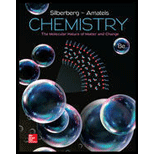
Concept explainers
(a)
Interpretation:
Unidentified species and the shorthand notation have to be written in the given transmutations where gamma irradiation of a nuclide yields a proton, a neutron.
Concept Introduction:
Nuclear reaction can be written in the shorthand notation with the parentheses. Bombarding particle, that is projectile can be represented as first symbol in the parentheses and the emitted can be represented as the second particle in the parentheses.
Parent nucleus and daughter nucleus can be represented in the front part of the parentheses and back part of the parentheses respectively. For example:
Common particles in radioactive decay and nuclear transformations are mentioned below,
Balancing nuclear reaction equation: The balanced nuclear reaction should conserve both mass number and atomic number.
- The sum of the mass numbers of the reactants should be equal to the sum of mass numbers of the products in the reaction.
- The sum of
atomic numbers (or the atomic charge) of the reactants should be equal to the sum of atomic numbers (or the atomic charge) of the products in the reaction.
(a)
Explanation of Solution
The given unbalanced
According to the law of conservation of
Missing species is determined as follows,
The elemental symbol of the unidentified species is
Therefore, the shorthand notation of the given transmutation is
(b)
Interpretation:
Unidentified species and the shorthand notation have to be written in the given transmutations where bombardment of
Concept Introduction:
Nuclear reaction can be written in the shorthand notation with the parentheses. Bombarding particle, that is projectile can be represented as first symbol in the parentheses and the emitted can be represented as the second particle in the parentheses.
Parent nucleus and daughter nucleus can be represented in the front part of the parentheses and back part of the parentheses respectively. For example:
Common particles in radioactive decay and nuclear transformations are mentioned below,
Balancing nuclear reaction equation: The balanced nuclear reaction should conserve both mass number and atomic number.
- The sum of the mass numbers of the reactants should be equal to the sum of mass numbers of the products in the reaction.
- The sum of atomic numbers (or the atomic charge) of the reactants should be equal to the sum of atomic numbers (or the atomic charge) of the products in the reaction.
(b)
Explanation of Solution
The given unbalanced nuclear equation is,
According to the law of conservation of atomic mass and number, the unknown element can be predicted.
Missing species is determined as follows,
The elemental symbol of the unidentified species is
Therefore, the shorthand notation of the given transmutation is
(c)
Interpretation:
Unidentified species and the shorthand notation have to be written in the given transmutations where bombardment of
Concept Introduction:
Nuclear reaction can be written in the shorthand notation with the parentheses. Bombarding particle, that is projectile can be represented as first symbol in the parentheses and the emitted can be represented as the second particle in the parentheses.
Parent nucleus and daughter nucleus can be represented in the front part of the parentheses and back part of the parentheses respectively. For example:
Common particles in radioactive decay and nuclear transformations are mentioned below,
Balancing nuclear reaction equation: The balanced nuclear reaction should conserve both mass number and atomic number.
- The sum of the mass numbers of the reactants should be equal to the sum of mass numbers of the products in the reaction.
- The sum of atomic numbers (or the atomic charge) of the reactants should be equal to the sum of atomic numbers (or the atomic charge) of the products in the reaction.
(c)
Explanation of Solution
The given unbalanced nuclear equation is,
According to the law of conservation of atomic mass and number, the unknown species can be predicted.
Missing species is determined as follows,
By analyzing the X, atomic number of X is 2 and the atomic mass is 4. So the unidentified species is an alpha
Therefore, the shorthand notation of the given transmutation is
Want to see more full solutions like this?
Chapter 24 Solutions
Chemistry: The Molecular Nature of Matter and Change
 ChemistryChemistryISBN:9781305957404Author:Steven S. Zumdahl, Susan A. Zumdahl, Donald J. DeCostePublisher:Cengage Learning
ChemistryChemistryISBN:9781305957404Author:Steven S. Zumdahl, Susan A. Zumdahl, Donald J. DeCostePublisher:Cengage Learning ChemistryChemistryISBN:9781259911156Author:Raymond Chang Dr., Jason Overby ProfessorPublisher:McGraw-Hill Education
ChemistryChemistryISBN:9781259911156Author:Raymond Chang Dr., Jason Overby ProfessorPublisher:McGraw-Hill Education Principles of Instrumental AnalysisChemistryISBN:9781305577213Author:Douglas A. Skoog, F. James Holler, Stanley R. CrouchPublisher:Cengage Learning
Principles of Instrumental AnalysisChemistryISBN:9781305577213Author:Douglas A. Skoog, F. James Holler, Stanley R. CrouchPublisher:Cengage Learning Organic ChemistryChemistryISBN:9780078021558Author:Janice Gorzynski Smith Dr.Publisher:McGraw-Hill Education
Organic ChemistryChemistryISBN:9780078021558Author:Janice Gorzynski Smith Dr.Publisher:McGraw-Hill Education Chemistry: Principles and ReactionsChemistryISBN:9781305079373Author:William L. Masterton, Cecile N. HurleyPublisher:Cengage Learning
Chemistry: Principles and ReactionsChemistryISBN:9781305079373Author:William L. Masterton, Cecile N. HurleyPublisher:Cengage Learning Elementary Principles of Chemical Processes, Bind...ChemistryISBN:9781118431221Author:Richard M. Felder, Ronald W. Rousseau, Lisa G. BullardPublisher:WILEY
Elementary Principles of Chemical Processes, Bind...ChemistryISBN:9781118431221Author:Richard M. Felder, Ronald W. Rousseau, Lisa G. BullardPublisher:WILEY





